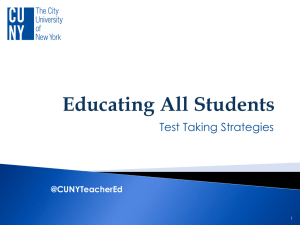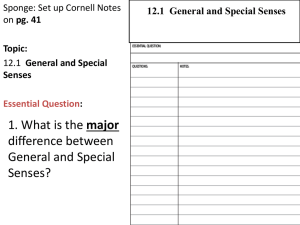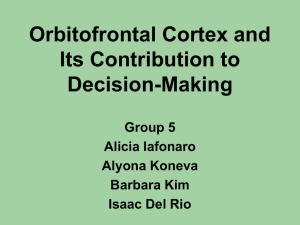Sensory Processing
advertisement
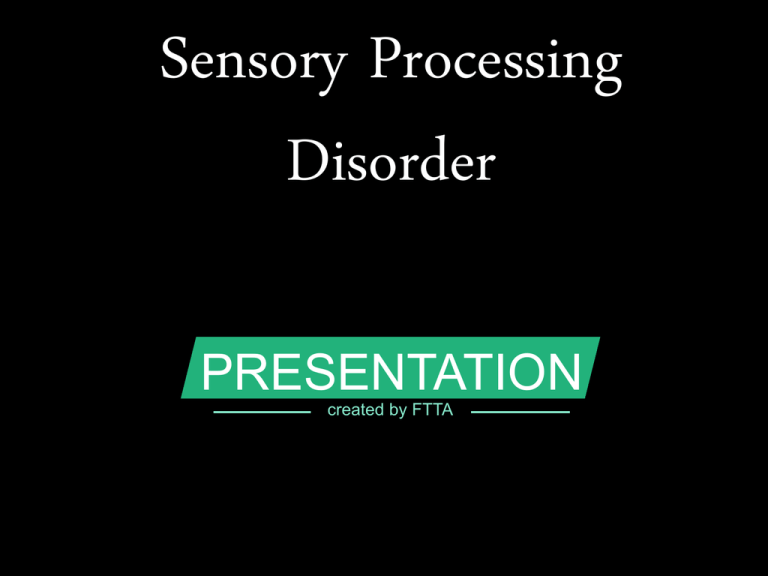
Sensory Processing Disorder PRESENTATION created by FTTA Disclaimer Please note that FTTA presenters, lectures and staff are not medical professionals. This information is designed to be used for education assistants under the supervision of professionals and some parts may be incorrect, outdated or the authors’ opinion. Sensory Processing Disorder A complex neurological condition that impairs a child’s functional skills The brain interprets all sensory information. When this gets misinterpreted, the child may feel overwhelmed with this sensory information they receive. As a reaction to this, ‘sensory seeking’ or avoidance behaviours may happen. FTTA 3 43 /// Sensory Integration (S.I.) describes how the brain sorts and organises the sensations we receive and how to use them 4 FTTA Adapted from Miller, 2006 43 Smell What are the senses? Gravity / Pressure Hearing Sight Taste Movement & Balance Touch 5 FTTA 43 /// What is Sensory Processing Disorder? 1 The brain and nervous system receive 2 The central nervous system sends the information from all body parts about the world from the senses. messages throughout the body. These messages affect the functions of the body. 3 If there is a miscommunication from one 4 Functions that get affected include: part to another, it affects other functions too. muscle movement, coordination, learning, behaviour, emotions, thought, memory… 5 FTTA This is very uncomfortable for the child and they may react in unusual ways. 6 43 /// So… Difficulties organising information Affects understanding of what they are: touching tasting hearing feeling FTTA seeing 7 43 /// Which then leads to Strong emotional behaviours Coping strategies Physically Meltdowns hurting oneself Applying FTTA pressure biting Seek out sensory experiences Avoidance Touching interesting textures 8 43 The child is not doing the behaviour to annoy you. The brain wants a sensory experience to regulate their feelings and emotions. You need to use appropriate strategies and resources to give them this experience so they can feel calm and normal. FTTA 9 43 People with SPD experience their world as either: FTTA Hypersensitive Over reactive Sensory avoidance Hyposensitive Under reactive Sensory seeker 10 43 Clumsy Academic failure Anxiety Labels Poor self-concept Aggression Inability to make Depression friends or be part of a group “Out of control” Disruptive FTTA 11 43 /// Duty of Care Extra supervision Teaching peers about needs of child and reactions FTTA Extra assistance on play equipment Use non-toxic products, glues, paints etc Risk taker Strategic management plan for meltdowns Close monitoring of sensory needs Predicting needs to avoid meltdowns Backup activity Sensory resources /// Extra Care 12 43 Correct diagnosis is important! Many children with ADHD and ASD also have SPD Sensory Processing /// Disorder FTTA 13 43 /// Types of treatments & programs 1 Sensory Equipment & Tools 2 Alternative listening and music 3 Daily massage, sensory therapy experience program according to needs 4 FTTA Fundamental movement skills program 14 43 /// Sensory tools FTTA 15 43 Extra Strategies for EAs Students with SPD require a few modifications to for their day • Know the needs of the child. Are they hypo or hyper • stimulated? This will affect their behaviour a lot. • Preventative strategies. Use the sensory resources – do not think you can ‘train’ them out of their sensory seeking behaviours. • Remember the brain misinterprets the information it receives, this is why the chid acts so differently because they are trying to feel what is normal for them. • Work closely with the OT and other therapists. Learn the strategies and incorporate them into the day. • Social skills to peers to include SPD child into play and socialising FTTA 16 43 Strategies for EAs • The child is not deliberating breaking their pencil or toys. Pressure senses information is incorrectly received. Supply resources that can withstand banging and rough play. • Have extra pencils already sharpened to reduce lost time replacing broken tips. • Instead of thin paper, use thicker card so if the child needs to use an eraser, they are less likely to tear the paper • Closely monitor noise – ear muffs to block sound? Music to stimulate? • Learn a fundamental movement skills program. Large spinning tops, barrels to roll in , pretending to have a rolling pin on your body can have amazing calming affects on the child FTTA 17 43 Strategies for EAs • Work with a team. Have a strategic management plan to prevent meltdowns and what to do if a meltdown occurs. • Teach peers to respect and not touch the child’s sensory tools and equipment. • Playdo, paint, gluing, sandpit and other sensory experiences can be too much for the child. Punishing the child for not participating will not help. Try and modify the activity. For instance, finger painting with the paint in a ziplock bag? • If smells are offensive, check that your deodorant or perfume is ok. • Position child in class in the best possible location for their needs. Ticking clock too noisy? Flickering fluoro lights? Too bright? FTTA 18 43 Strategies for EAs • Regular movement time for the movement sensory seekers • Is extra assistance when doing obstacle courses needed? Balance and coordination affected? Modify some parts if the risk of falling or injury is too high. • Some behaviours are very distracting, such as constantly kicking the table. Find a quieter resource. Such as elastic resistance band around ankles that when stretched may create the pressure experience the child is seeking • For the fussy eaters, do not single them out with their inadequate and limited diet. What you see could be unknown progress! • Sensitive fingers for writing – what about typing? Videoing verbal answers? Scribe? FTTA 19 43 Want to know more? Sensory Clothing and Toys http://www.undercovertape.com/ www.frilledtobits.com.au/sensory http://www.seamsaway.com.au/ http://www.itmakessense.com.au/ http://www.merrygomonkey.com/collections/teddy -hair-the-first-bear-with-hair Links for Sensory Tools / Equipment http://www.sensorytools.net/ http://www.spdaustralia.com.au/ http://www.lifeskills4kids.com.au/ http://www.senseabilities.com.au/ http://www.skillbuilders.com.au/ FTTA http://www.frilledtobits.com.au/sensory 20 43
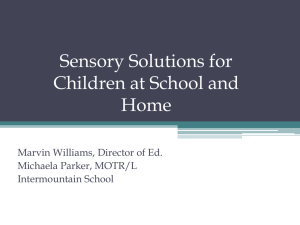
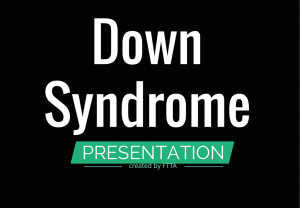
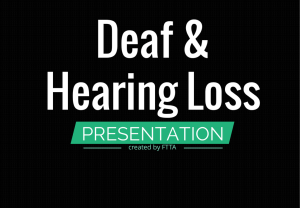
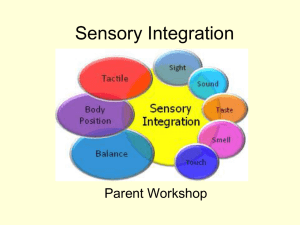


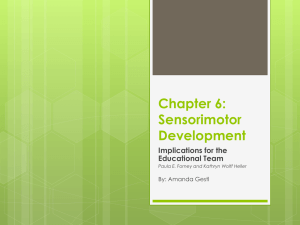
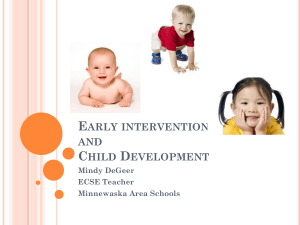
![Memory and Concentration [PPT]](http://s2.studylib.net/store/data/005229782_1-4c0c5b1e43659ea26205e374b2b31a91-300x300.png)
